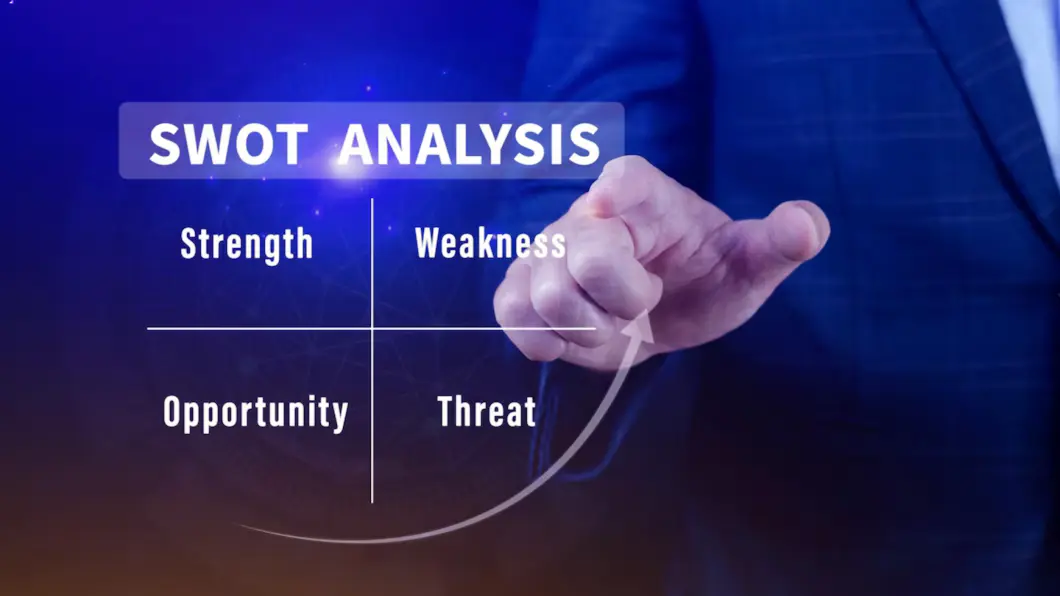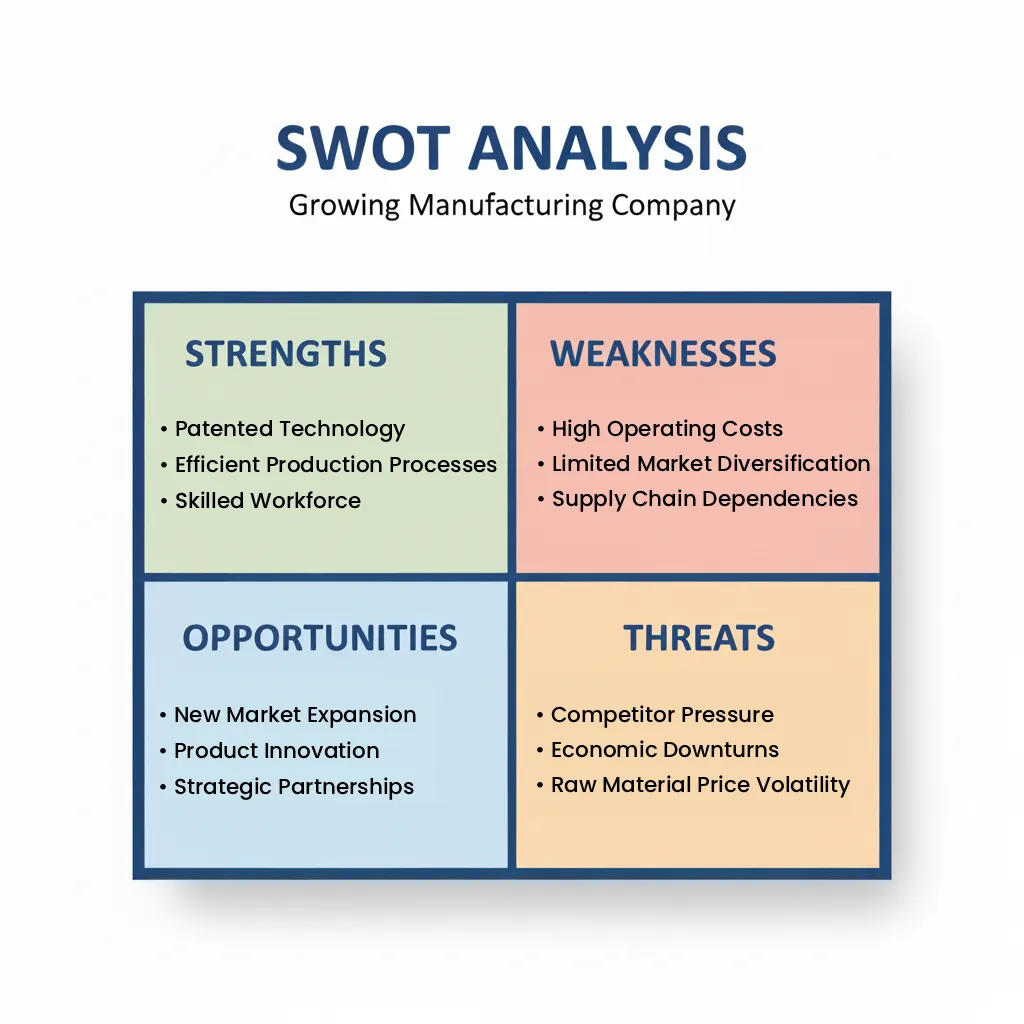Whether you are a start-up or an established brand, as a forward-looking company, you are always looking for ways to stand out from your competition. While you are aware of what’s happening inside your company or what the competitors are doing, many internal and external factors tend to escape your sight until you perform a SWOT analysis.
Let’s jump straight in and find out what is SWOT analysis. Discover how your ERP software is your tech partner in performing SWOT analysis, developing strategies, and unlocking specific insights driven by data.
What is SWOT Analysis?
SWOT analysis is a strategic planning tool – an exercise designed to identify key factors that impact your business performance. The full form of SWOT is Strengths, Weaknesses, Opportunities, and Threats.
Performed using a SWOT matrix by company stakeholders involved in business strategy, SWOT analysis helps you understand where your business is heading and where the scope for improvement lies. Unlike PEST analysis, which only focuses on the external factors, the SWOT analysis process distinguishes between internal versus external factors that could affect a business.
Internally, it gives you a window into your company’s strengths and weaknesses – factors you have some control over. As a result, you come to know about areas where you have a clear edge in the market. You also gain a fresh look at what’s holding your business back from reaching a notch higher.
On the other hand, you have opportunities and threats, which are external factors affecting your business environment that you cannot control, but can make them work to your advantage.
Breaking Down The Elements of the SWOT Framework
Strengths
This is a list of internal factors that highlight your organization’s capabilities and competitive advantage. It could be anything that makes you unique.
- Are you the key supplier for an OEM?
–> Strong brand reputation and financial stability
- Do you have technical expertise and talented human resources?
–> Such internal resources are an asset for your organization.
Weaknesses
It is equally important to pay attention to internal weaknesses so that you can work towards improving them. Here’s what you can uncover with SWOT analysis.
- Have your customers been expecting innovative products?
-> Low investment in R&D may translate into lost customers
- Do you still rely on traditional manual data entry systems?
-> Slows down routine processes and leads to frequent errors & delays
Opportunities
Spotting opportunities helps you develop a business plan, analyze the competitive landscape, and build on internal capabilities. Some external opportunities you could be looking at:
- Is your key customer looking for a strategic supplier?
–> You may need to shift plant location, or invest in technological advancements to be the right fit.
- How will your procurement benefit from reduced import tariffs?
–> Cost of production may come down, and more liquidity to fund expansion.
Threats
If you can identify threats in advance using SWOT analysis, you are better prepared to reduce their negative impact on your business.
- Critical raw material cost likely to stay higher in the foreseeable future?
–> Strategic procurement required to negotiate better deals with suppliers.
- Due to changing customer preferences, demand for some of your products will eventually fade.
–> Focus on trending products high in demand among your target segment.
How Does ERP Software Enable SWOT Analysis?
An enterprise resource planning (ERP) system is your centralized, single source of information that stores, manages, and can analyze data from all departments and multiple entities of the organization, giving you enhanced control and visibility into your financial resources and operations.
When used for performing SWOT analysis, the ERP system supplies the data you need to make a quantitative assessment of key areas affecting your business. So instead of relying on a subjective overview, you get confident numbers on key metrics – the numbers you can trust.
Let’s take a look at how ERP solutions facilitate good SWOT analysis and achieve your business goals.
1. Building on Strengths
A. Inventory Turnover
High inventory turnover signals superior inventory management practices. It also indicates that your inventory holding costs are low. With promising numbers at your disposal, you can use this information for:
- Demand forecasting using your ERP system.
- Invest in supplier relationships to reduce lead time
- Implement Just-in-Time inventory strategy
B. Revenue
The ERP software system allows you to analyze how much revenue you generate from top-selling products and regions, compare revenue growth across regions, and identify seasonal sales patterns. Consequently, you can invest in marketing channels and customer relationship management to upsell more products in the region with high product demand.
2. Overcoming Weaknesses
A. Fixed asset performance
In manufacturing, a range of fixed assets can include buildings, vehicles, machinery, etc. The fixed asset management software in ERP helps you track the entire asset lifecycle. If your ERP flags increasing machinery repair costs over the last quarter, it is a clear indication for you to take corrective measures and consider upgrading your machinery.
B. Pending customer dues
A healthy cash flow can soon lead to a liquidity crunch if your key customers have not been meeting their payment commitments. Accounts receivable automation gives you the right tools to:
- Automate billing & ensure accurate, faster payment
- Communicate clearly with customers
- Track dues with greater efficiency
3. Identifying Opportunities
A. Forecasting tools
ERP for manufacturing industry can analyze historical product data and predict future demand. Rising product demand may require you to invest in capacity building and communicate with suppliers to prepare for higher order sizes. This becomes even more important when existing or new competitors are eyeing the same market.
B. Customer feedback
With CRM integrated with your ERP system, you can easily track customer service requests and interactions across multiple sales channels. This is an opportunity to fulfill unmet customer needs, improve your product/service, and deliver a superior customer experience.
4. Preparing for Threats
A. Changing regulations
Changes in government policy may adversely affect your operations. Nonetheless, you have to face them head-on. Whether it is changes in GST rules or revisions in tariff rates, your ERP solution is quick to adapt to the revised rate structure and predict future cash flows.
B. Supply chain disruptions
No business is immune to supply chain disruptions. Yet, steps can be taken to mitigate risks. ERP software ensures improved visibility into supplier networks and lead times. You can tap new suppliers if the data indicates supply bottlenecks. Real-time visibility and collaboration via the system safeguard you against several supply chain risks.
Conclusion
SWOT analysis is a powerful tool that supports strategic decision-making by identifying your company’s internal strengths and weaknesses, and determining external threats and opportunities. Make sure that you involve a diverse group of stakeholders to avoid bias and base your analysis on accurate data.
Sage X3 ERP is a growth-oriented business solution that simplifies SWOT analysis by providing accurate, real-time data and advanced analytical tools. It centralizes your global data, ensuring that every business decision is based on a unified view of your organization.
SWOT Analysis FAQs
1. What Does SWOT Stand For?
The acronym SWOT in SWOT analysis stands for Strengths, Weaknesses, Opportunities, and Threats.
2. Why is a SWOT Analysis Used?
SWOT analysis is a planning tool to discover the internal strengths and weaknesses of the company. It is also used to minimize threats that exist in the external environment and to exploit the opportunities by taking timely strategic actions.
3. What Are the Limitations of a SWOT Analysis?
Although SWOT analysis is important, its static nature means that it needs to be regularly reviewed to align with the company’s current position and market shifts. SWOT analysis may also be subject to leadership bias, which may negatively impact the organization by hiding the true picture.






